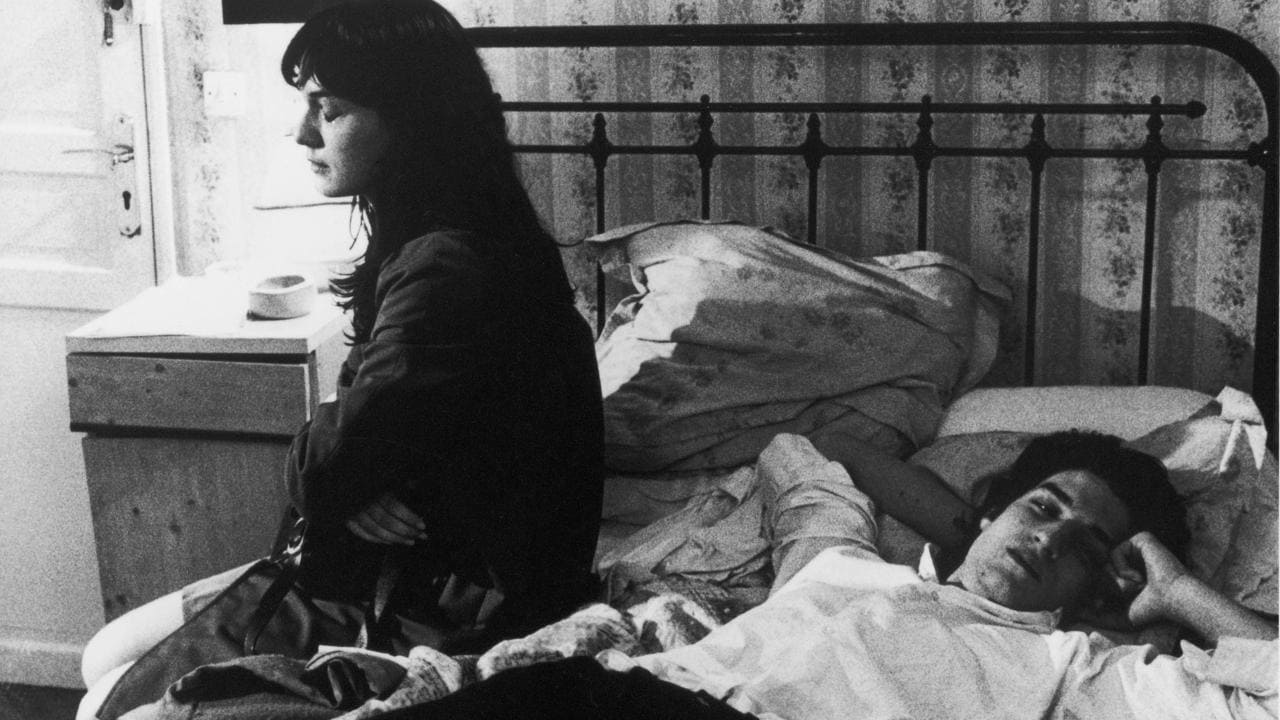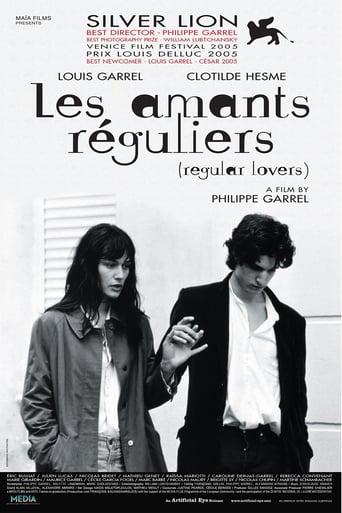

Seeing Les Amants Reguliers calls immediately for comparison with Bertolucci's movie 'The Dreamers', in my opinion the best film made about the 1968 revolt of students in Paris. Actually director Philippe Garrel does not seem to avoid comparing with his much more famous colleague, sharing the principal actor and even including a direct replica eye-in-viewer-eye about an older film of Bertolucci. And yet, LAR is a different film, and an interesting one.The story line seems also familiar. The movie starts with long scenes of the 1968 'emeutes', maybe among the best done until now. The film is made in black-and-white, and the perspective of the static camera on one side or the other of the barricade reminds Eisenstein. Then, as in The Dreamers, the action moves in the Parisian flat where the heroes of the defeated revolt make art, smoke drugs, dream, and fall for one other. There is no direct social comment, no real explanation of the background of the revolt. The movie focuses on the psychology of the characters and on the love story between the main characters. It's like a premonition of the process of transition to the establishment that the generation of the 1968 went through, it's just that not all the participants may adapt or survive.The film is more about the characters than about the events. And it is merely for the style it will be remembered about. The black-and-white cinema is memorable not only in the revolution scenes, but also when looking at the characters evolution. Many sequences are enhanced by a technique that is derived from the silent films movies, with long takes accompanied by a off piano tune. The effect is exquisite. Yet the length of the film is hardly justified, it lasts more than three hours and I doubt that cutting it to only two hours would have been a miss - actually I am convinced it's quite a contrary.Without raising at the depth and subtlety of Bertolucci's movie LAR is another perspective to remember about one of the more important years in the history of France and of the world in the 20th century.
... View MoreThis is clearly a French film. It is about young group of idealist/revolutionary/anarchistic people. It moves very slowly. Long takes. LOng closeups. A minute or more devoted to an attempt to light a pipe full of hash/opium. A long take on how a group overturns a car and burns it. It is a black and white film. The subtitles were white, so about a third of the time they were unreadable. (Why do they do this?) I walked out after about an hour and three quarters when it became clear that this picture was going nowhere, slow. I was not the first to walk out. It was the first time I walked out of a picture in my long lifetime. (Well, maybe the second.)
... View MoreThis film is probably the best new French film I've seen in this century so far. There have been some great ones including Noe's Irreversible, Green's Le Pont des Arts and Hadzihalilovic's Innocencebut none of them come close to Les Amants Reguliers' timeless glory.The movie is a description of the events of May 68 and what followed in the wake of it and furthermore it is and update of, and a homage to, the Nouvelle Vague-movies of those days. Concerning the depiction of the riots in Paris the movie is meticulously accurate (I'm only 19 and I wasn't there myself but you know what I mean)and the almost real-time and very long riot scenes set the stage perfectly for the aftermath of the events in the streets of Paris. The riots are not glorified or beautifully photographed like the ones in Bertolucci's The Dreamers (to which the movie is comparable in many ways) instead they are filmed in grimy black and white shots courtesy of the excellent William Lubtchansky. The love story that is the movie's main concern after the riots in 68 is filmed in stunning and far less blurred shots and manages to evoke true feelings of love and adolescent confusion in the midst of the otherwise politically concerned and seemingly cold environment.This film is a beautiful love story and it radiates through it that the director wants to depict his own experiences of those mythical late 60's which makes the film all the more compelling. But the film is also a homage to the whole Nouvelle Vague canon. Much of the dialogue evokes early Truffaut, and the length and non-action and plot less structure is reminiscent of Eustache or Rivette. There are even Godard-like verfremdung-effects with the persons looking directly into the camera and even addressing Bernardo Bertolucci directly. This film is no doubt an answer song to Bertolucci's The Dreamers and it is also a Nouvelle Vague homage but still it stands by itself as a beautiful and radiant love story.Bottom line: This movie is incredible and if you love French cinema you shouldn't sleep on it. It may be the finest french film since Eustache's La Mamain et la Putain.
... View MoreI saw this at the Toronto Inter. Film Festival in Sept. 2005. The description seemed intriguing--how wrong I was! This could easily be the worst movie I have ever seen--in 50 years! I see the director is my age (b. 1948) and lived with Nico of the Velvet Underground, which leads us to Andy Warhol, which coincidently is the one I thought of while watching this--Warhol's 24+ hour movies of nothing much happening. This is not art, this is boredom.Specifically: black & white. OK, maybe...but what is the purpose here? Surely they had color in 1968! And there is no contrast with the present. And yes, the subtitles were in white, naturally. I don't think I missed much, but that made about 20% of them illegible.Next, it's pure chronological order, but with seemingly random events thrown in. What's the purpose of the conversation with the old man at the dinner table? It adds nothing to the movie. There were many similar scenes--almost like someone took a camcorder and filmed random people and spliced them together to make a movie.Plot? None. The "riot" consists of some figures in the distance occasionally heaving a rock off screen. Mostly it's an excruciating length of time watching people (in the distance!) stand around. The repetitive opium smoking is just as boring. When the main character got a cute girlfriend, I perked up, but no, she was boring too! This is perhaps the only French film I've seen where no one takes off their clothes. Probably they were too bored to bother.Romance? None. The girl seems totally indifferent to everything--maybe her sculpture holds some interest, but if it does, we're not shown that. We are completely indifferent to the fate of the characters because they are all unappealing. Maybe that's the point of all this?
... View More